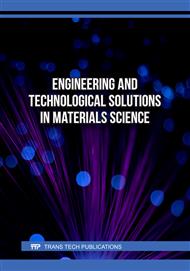[1]
K. Xia, Finite element modeling of tire/terrain interaction: Application to predicting soil compaction and tire mobility, Journal of Terramechanics. 48(2) (2011) pp.113-123.
DOI: 10.1016/j.jterra.2010.05.001
Google Scholar
[2]
D. Vieira, R. Orjuela, M. Spisser, M. Basset, Longitudinal Vehicle Control based on Off-road Tire Model for Soft Soil Applications, IFAC-PapersOnLine. 54(10) (2021) pp.304-309.
DOI: 10.1016/j.ifacol.2021.10.180
Google Scholar
[3]
C.H. Sr, J. Gao, M. Zhang, X. Tan, Numerical simulation of rigid tire-soil interaction based on discrete element method, International Conference on Computational Modeling, Simulation, and Data Analysis. (CMSDA 2021) (2022) SPIE.
DOI: 10.1117/12.2627691
Google Scholar
[4]
H. Ge, J.C. Quezada, V. Le Houerou, C. Chazallon, Multiscale analysis of tire and asphalt pavement interaction via coupling FEM–DEM simulation, Engineering Structures. 256 (2022) p.113925.
DOI: 10.1016/j.engstruct.2022.113925
Google Scholar
[5]
C. Hu, J. Gao, J. Diao, X. Song, Numerical simulation of tire steering on sandy soil based on discrete element method, AIP Advances. 11(1) (2021) p.015015.
DOI: 10.1063/5.0034585
Google Scholar
[6]
H. Yamashita, P. Jayakumar, M. Alsaleh, H. Sugiyama, Physics-based deformable tire–soil interaction model for off-road mobility simulation and experimental validation, Journal of Computational and Nonlinear Dynamics. 13(2) (2018).
DOI: 10.1115/1.4037994
Google Scholar
[7]
T. Wasfy, H. Wasfy, P. Jayakumar, S. Sanikommu, Validation of a high-fidelity finite element tire model on pavement, International Design Engineering Technical Conferences and Computers and Information in Engineering Conference. (2020) American Society of Mechanical Engineers.
DOI: 10.1115/detc2020-22763
Google Scholar
[8]
C.W. Fervers, Improved FEM simulation model for tire–soil interaction, Journal of Terramechanics. 41(2-3) (2004) pp.87-100.
DOI: 10.1016/j.jterra.2004.02.012
Google Scholar
[9]
M.M. Shahzamanian, M. Parsazadeh, and P.D. Wu, Numerical and analytical analyses of the formability and fracture of AA7075-O aluminum sheets in hemispherical punch tests, International Journal of Solids and Structures. 286 (2024) 112558.
DOI: 10.1016/j.ijsolstr.2023.112558
Google Scholar
[10]
M.M. Shahzamanian, S.S. Akhtar, A.F.M. Arif, W.J. Basirun, K.S. Al-Athel, M. Schneider, N. Shakelly, A.S. Hakeem, A.A. Abubakar, P.D. Wu, Thermo-mechanical properties prediction of Ni-reinforced Al2O3 composites using micro-mechanics based representative volume elements, Scientific Reports. 12(1) (2022) 11076.
DOI: 10.1038/s41598-022-14685-x
Google Scholar
[11]
M.M. Shahzamanian, M. lin, M. Kainat, N. Yoosef-Ghodsi, S. Adeeb, Systematic literature review of the application of extended finite element method in failure prediction of pipelines, Journal of Pipeline Science and Engineering. 1(2) (2021) 241-251.
DOI: 10.1016/j.jpse.2021.02.003
Google Scholar
[12]
M.M. Shahzamanian, Shock wave propagation in micro-mechanics based Representative Volume Element of cement paste, Materials Today Communications. 25 (2020) 101559.
DOI: 10.1016/j.mtcomm.2020.101559
Google Scholar
[13]
X. Tang, J. Xie, H. Xie, H. Zhang, Predictions of three-dimensional contact stresses of a radial truck tire under different driving modes, Advances in Mechanical Engineering. 14(4) (2022) 16878132221092346.
DOI: 10.1177/16878132221092346
Google Scholar
[14]
C.C. Sullivan, H. Yamashita, H. Sugiyama, Reduced Order Modeling of Deformable Tire-Soil Interaction With Proper Orthogonal Decomposition, Journal of computational and nonlinear dynamics. 17(5) (2022) 051009.
DOI: 10.1115/1.4053592
Google Scholar
[15]
N. Moslem, G. Hossein, Numerical simulation of tire/soil interaction using a verified 3D finite element model, Journal of Central South University. 21(2) (2014) 817-821.
DOI: 10.1007/s11771-014-2005-5
Google Scholar
[16]
T. Wang, Z. Dong, K. Xu, S. Ullah, D. Wang, Y. Li, Numerical simulation of mechanical response analysis of asphalt pavement under dynamic loads with non-uniform tire-pavement contact stresses, Construction and Building Materials. 361 (2022) 129711.
DOI: 10.1016/j.conbuildmat.2022.129711
Google Scholar
[17]
Abaqus, V., 6.14 Documentation, Dassault Systemes Simulia Corporation. 651(6.2) (2014).
Google Scholar
[18]
T.J. Truster, DEIP, discontinuous element insertion Program—Mesh generation for interfacial finite element modeling, SoftwareX. 7 (2018) 162-170.
DOI: 10.1016/j.softx.2018.05.002
Google Scholar
[19]
M. Shiraishi, A. Miyori, E. Takahashi, Tire and Science and Technology [J]. (2000).
Google Scholar
[20]
A.H. Sufian, T.Z. Xun, A.N.S.Z. Abidin, A.S. Jamaludin, M.N.M. Razali, Study On Tire Tread Design Effect onto Tire-road Contact Behavior Through FEM, in Recent Trends in Manufacturing and Materials Towards Industry 4.0. Springer. (2021) 893-902.
DOI: 10.1007/978-981-15-9505-9_78
Google Scholar
[21]
M.M. Shahzamanian, Anisotropic Gurson‐Tvergaard‐Needleman plasticity and damage model for finite element analysis of elastic‐plastic problems, International Journal for Numerical Methods in Engineering. 115(13) (2018)1527-1551.
DOI: 10.1002/nme.5906
Google Scholar
[22]
M.M. Shahzamanian, Implementation of a rate dependent tensile failure model for brittle materials in ABAQUS, International Journal of Impact Engineering. 97 (2016) 127-147.
DOI: 10.1016/j.ijimpeng.2016.05.022
Google Scholar
[23]
J. Ma, A. Kolla, J.D. Summers, P.F. Joseph, V.Y. Blouin, S Biggers, Numerical Simulation of New Generation Non-Pneumatic Tire (TWEEL™) and Sand, International Design Engineering Technical Conferences and Computers and Information in Engineering Conference. (2009).
DOI: 10.1115/detc2009-87263
Google Scholar
[24]
L. R. Alejano, A. Bobet, Drucker–prager criterion, in The ISRM Suggested Methods for Rock Characterization, Testing and Monitoring: 2007-2014. Springer. (2012) 247-252.
DOI: 10.1007/978-3-319-07713-0_22
Google Scholar
[25]
S. Helwany, Applied soil mechanics with ABAQUS applications. (2007) John Wiley & Sons.
Google Scholar
[26]
R.P. da Silva, M.M. Rolim, I.F. Gomes, B.M.C.M. Maciel, P.F.S. Ortiz, E.M.R. Pedrosa, R.P. de Lima, Comparing pseudo-analytical solutions with 2D and 3D numerical simulations of soil stress induced by agricultural field traffic, Biosystems Engineering. 221 (2022) 195-207.
DOI: 10.1016/j.biosystemseng.2022.07.005
Google Scholar
[27]
A. Azimi, J. Kövecses, J. Angeles. Wheel-soil interaction model for rover simulation based on plasticity theory, IEEE/RSJ International Conference on Intelligent Robots and Systems (2011) IEEE.
DOI: 10.1109/iros.2011.6048200
Google Scholar
[28]
Documentation, A. and U. Manual, Version 6.14, Dassault systemes (2010).
Google Scholar
[29]
https://imechanica.org/node/21742.
Google Scholar
[30]
I. El Fahham, W. Crosby, A. Gaied, Analysis of vehicle tire strength test, Journal of Terramechanics. 105 (2023) 1-9.
DOI: 10.1016/j.jterra.2022.10.001
Google Scholar
[31]
D. Abdizadeh, M.S. Pakbaz, B. Nadi, Numerical modeling of lateral dynamic compaction on the slope in dry sand, KSCE Journal of Civil Engineering. 25(2) (2021) 398-403.
DOI: 10.1007/s12205-020-2344-8
Google Scholar
[32]
http://hpwizard.com/tire-friction-coefficient.html.
Google Scholar


